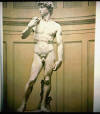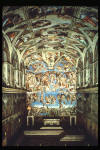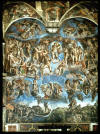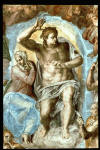Sculpture:

"One of Michelangelo's
best known observations about sculpture is that the artist must
proceed by finding the idea - the image locked in the stone, as
it were - so, by removing the excess stone, the sculptor
extricates the idea..."
- Gardner's
Art Through The Ages,
11th edition, Vol. II, p. 645

"In 1501, the city of
Florence asked Michelangelo to work a great block of marble,
called "The Giant," left over from an earlier aborted
commission. From this stone Michelangelo crafted David,
the defiant hero of the Florentine Republic and, in so doing,
assured his reputation then, and now, as an extraordinary
talent. This early work reveals Michelangelo's fascination
with the human form, and David's formal references to
classical antiquity surely appealed to Julius II, who associated
himself with the humanists and with Roman emperors. Thus,
this sculpture and the fame that accrued to Michelangelo on its
completion called the artist to the pope's attention, leading to
major papal commissions....
"Michelangelo doubtless
had the classical male nude in mind. He, like many of his
colleagues, greatly admired Greco-Roman statues, his knowledge
limited mostly to
Roman sculptures and
Roman copies
of Greek art.
In particular, classical sculptors' skillful and precise
rendering of heroic physique impressed Michelangelo...."
- Gardner's
Art Through The Ages,
11th edition, Vol. II, p. 646
Frescos of the
Sistine Chapel:

"Julius II gave ...
Michelangelo the commission to paint the ceiling of the Sistine
Chapel in 1508. The artist, insisting that painting was
not his profession, assented.... Michelangelo faced enormous
difficulties in painting the Sistine ceiling. His relative
inexperience in the fresco technique; the ceiling's dimensions
(some five-thousand eight-hundred square feet); its height above
the pavement (almost seventy feet); and the complicated
perspective problems the vault's height and curve presented.
Yet, in less than four years Michelangelo produced an
unprecedented work - a monumental fresco incorporating the
patron's agenda, Church doctrine, and the artist's interests.
Depicting the most august and solemn themes of all, the
Creation, Fall, and Redemption of humanity (most likely selected
by Julius II with input from Michelangelo and a theological
adviser), Michelangelo spread a colossal decorative scheme
across the vast surface. He succeeded in weaving together
more than three-hundred figures in an ultimate grand drama of
the human race.

"A long sequence of
narrative panels, describing the Creation, as recorded in the
Biblical book Genesis, runs along the crown of the vault...
The conception of the whole design no doubt contributed to the
perception of Julius II as a spiritual leader, temporal power,
and cultured man."
- Gardner's
Art Through The Ages,
11th edition, Vol. II, p. 648

"One of the ceiling's
central panels is Creation of Adam. Michelangelo did not
paint the traditional representation but a bold, entirely
humanistic interpretation of the momentous event. God and
Adam confront each other in a primordial, unformed landscape
where Adam is still a material part, heavy as earth. The
Lord transcends the earth, wrapped in a billowing cloud of
drapery and borne up by his powers. Life leaps to Adam
like a spark from the extended and mighty hand of God. The
communication between gods and heroes, so familiar in classical
myth, is here concrete; made of the same substance, both are
gigantic. This blunt depiction of the Lord as ruler of
Heaven in the Olympian pagan sense indicates how easily High
Renaissance thought joined pagan and Christian traditions.
Yet the classical trappings do not obscure the Christian
message."
- Gardner's
Art Through The Ages,
11th edition, Vol. II, p. 650

"Among [pope] Paul III's first papal commissions was a large
fresco for the Sistine Chapel. Michelangelo agreed to
paint the large-scale Last Judgment fresco on the chapel's altar
wall. Here Michelangelo depicted Christ as the stern Judge
of the world ... The choirs of Heaven surrounding him
pulse with anxiety and awe. Trumpeting angels, the
ascending figures of the just, and the downward-hurtling figures
of the Damned crowd into the spaces below. One the left,
the dead awake and assume flesh; on the right, demons, whose
gargoyle masks and burning eyes [similar to
Romanesque
depictions], torment the Damned."
- Gardner's
Art Through The Ages,
11th edition, Vol. II, p. 661

"Martyrs who suffered especially agonizing deaths crouch below
the Judge. One of them, Saint Bartholomew, who was skinned
alive, holds the flaying knife and the skin, its face a
grotesque self-portrait of Michelangelo. The figures are
huge and violently twisted, with small heads and contorted
features. Yet, while this immense fresco impresses on
viewers Christ's wrath on Judgment Day, it also holds out hope.
A group of saved souls - the elect - crowd around Christ, and on
the far right appears a figure with a cross, most likely the
Good Thief (crucified with Christ) or a saint martyred by
crucifixion, such as Saint Andrew."
- Gardner's
Art Through The Ages,
11th edition, Vol. II, p. 661
|